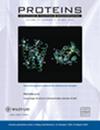Rigidifying Flexible Sites: A Promising Strategy to Improve Thermostability of Lysophospholipase From Pyrococcus abyssi
IF 2.8
4区 生物学
Q2 BIOCHEMISTRY & MOLECULAR BIOLOGY
引用次数: 0
Abstract
High thermostability of the enzymes is one of the distinguishing characteristics that increase their industrial utility. In the current research work, rigidifying the flexible amino acid residues of a lysophospholipase (Pa‐LPL) from刚性柔性位点:提高阿贝斯裂殖球菌溶血磷脂酶热稳定性的有效策略
酶的高耐热性是提高其工业实用性的显著特征之一。在目前的研究工作中,我们采用了一种蛋白质工程学方法,对来自 Pyrococcus abyssi 的溶血磷脂酶(Pa-LPL)的柔性氨基酸残基进行刚性化处理,以提高其耐热性。通过重叠延伸聚合酶链反应修剪了 Pa-LPL 的 12 个氨基酸残基(50-61),从而构建了 Pa-LPL 的截短变体(t-LPL∆12)。截短的酶在 65°C 和 pH 值为 6.5 的条件下工作最佳,在 65°C-85°C 的条件下具有显著的恒温性。与野生型 Pa-LPL 相比,t-LPL∆12 在 65℃(最适温度)和 95℃时的半衰期(t1/2)分别延长了 5.8 倍和 1.2 倍。1 mM Cu2+ 能刺激 t-LPL∆12 的活性,其次是 Ca2+、Ni2+、Co2+ 和 Mg2+。底物对接和实验结果都表明,截短的酶可以水解多种对硝基苯酯。经计算,酶水解对硝基苯丁酸酯的 Km、Vmax 和 Kcat 分别为 1 ± 0.087 mM、1456 ± 36.474 U/mg 和 1.397 × 1011 min-1。总之,t-LPL∆12 具有广泛的底物特异性和恒温性等显著特点,是植物油脱胶的理想候选物质。
本文章由计算机程序翻译,如有差异,请以英文原文为准。
求助全文
约1分钟内获得全文
求助全文
来源期刊

Proteins-Structure Function and Bioinformatics
生物-生化与分子生物学
CiteScore
5.90
自引率
3.40%
发文量
172
审稿时长
3 months
期刊介绍:
PROTEINS : Structure, Function, and Bioinformatics publishes original reports of significant experimental and analytic research in all areas of protein research: structure, function, computation, genetics, and design. The journal encourages reports that present new experimental or computational approaches for interpreting and understanding data from biophysical chemistry, structural studies of proteins and macromolecular assemblies, alterations of protein structure and function engineered through techniques of molecular biology and genetics, functional analyses under physiologic conditions, as well as the interactions of proteins with receptors, nucleic acids, or other specific ligands or substrates. Research in protein and peptide biochemistry directed toward synthesizing or characterizing molecules that simulate aspects of the activity of proteins, or that act as inhibitors of protein function, is also within the scope of PROTEINS. In addition to full-length reports, short communications (usually not more than 4 printed pages) and prediction reports are welcome. Reviews are typically by invitation; authors are encouraged to submit proposed topics for consideration.
 求助内容:
求助内容: 应助结果提醒方式:
应助结果提醒方式:


